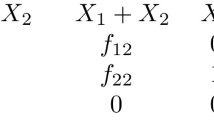Abstract
We study the usefulness of coupled redundancy as a mechanism for reduction in local noise in coupled map lattices and investigate the role of network topology, coupling strength, and iteration number in this mechanism. Explicit numerical simulations to measure noise reduction in coupled units connected in different topologies such as ring, star, small-world, random, and grid networks have been carried out. We study both symmetric and asymmetric networks. Linear stability analysis is presented to identify an optimal symmetric topology. The effect of rewiring is also investigated, and we find that dynamic links enhance the noise reduction capabilities.








Similar content being viewed by others
References
Argyris, A., Hamacher, M., Chlouverakis, K., Bogris, A., Syvridis, D.: Photonic integrated device for chaos applications in communications. Phys. Rev. Lett. 100, 194101 (2008)
Atay, F.M., Bıyıkoğlu, T., Jost, J.: Network synchronization: spectral versus statistical properties. Phys. D 224, 35–41 (2006)
Boccaletti, S., Grebogi, C., Lai, Y.C., Mancini, H., Maza, D.: The control of chaos: theory and applications. Phys. Rep. 329, 103–197 (2000)
Bouvrie, J., Slotine, J.J.: Synchronization and redundancy: implications for robustness of neural learning and decision making. Neural Comput. 23, 2915–2941 (2010)
Chang, H.C., Cao, X., Mishra, U.K., York, R.: Phase noise in coupled oscillators: theory and experiment. IEEE Trans. Microw. Theory Tech. 45, 604–615 (1997)
Choudhary, A., Kohar, V., Sinha, S.: Taming explosive growth through dynamic random links. Sci. Rep. 4, 4308 (2014)
Cuomo, K.M., Oppenheim, A.V.: Circuit implementation of synchronized chaos with applications to communications. Phys. Rev. Lett. 71, 65–68 (1993)
De, S., Sinha, S.: Effect of switching links in networks of piecewise linear maps. Nonlinear Dyn. 81, 1741–1749 (2015)
Dhople, S.V., Johnson, B.B., Dorfler, F., Hamadeh, A.O.: Synchronization of nonlinear circuits in dynamic electrical networks with general topologies. IEEE Trans. Circuits Syst. I Reg. Pap. 61, 2677–2690 (2014)
Guastello, S.J.: Chaos, catastrophe, and human affairs: Applications of Nonlinear Dynamics to Work, Organizations, and Social Evolution. Psychology Press, East Sussex (2013)
Jeter, R., Belykh, I.: Synchronization in on-off stochastic networks : windows of opportunity. IEEE Trans. Circuits Syst. I Reg. Pap. 62, 1260–1269 (2015)
Kaneko, K.: Theory and Applications of Coupled Map Lattices, vol. 12. Wiley, Hoboken (1993)
Kaneko, K., Tsuda, I.: Complex Systems: Chaos and Beyond: Chaos and Beyond: A Constructive Approach With Applications in Life Sciences. Springer, Berlin (2001)
Kia, B., Kia, S., Lindner, J.F., Sinha, S., Ditto, W.L.: Noise tolerant spatiotemporal chaos computing. Chaos Interdiscip. J. Nonlinear Sci. 24, 043110 (2014)
Kia, B., Kia, S., Lindner, J.F., Sinha, S., Ditto, W.L.: Coupling reduces noise: applying dynamical coupling to reduce local white additive noise. Int. J. Bifurc. Chaos 25, 1550040 (2015)
Kia, B., Lindner, J.F., Ditto, W.L.: Nonlinear dynamics based digital logic and circuits. Front Comput. Neurosci. 9, 49 (2015)
Kocarev, L., Galias, Z., Lian, S.: Intelligent Computing Based on Chaos, vol. 184. Springer, Berlin (2009)
Kohar, V., Ji, P., Choudhary, A., Sinha, S., Kurths, J.: Synchronization in time-varying networks. Phys. Rev. E 90, 022812 (2014)
Kohar, V., Kia, B., Lindner, J.F., Ditto, W.L.: Reduction of additive colored noise using coupled dynamics. Int. J. Bifurc. Chaos 26, 1650005 (2015)
Kohar, V., Sinha, S.: Emergence of epidemics in rapidly varying networks. Chaos Solitons Fractals 54, 127–134 (2013)
Li, X., Chen, G.: Synchronization and desynchronization of complex dynamical networks: an engineering viewpoint. IEEE Trans. Circuits Syst. I Fundam. Theory Appl. 50(11), 1381–1390 (2003)
Lipsitz, L.A., Goldberger, A.L.: Loss of complexity and aging: potential applications of fractals and chaos theory to senescence. JAMA 267, 1806–1809 (1992)
Lu, W., Atay, F.M., Jost, J.: Chaos synchronization in networks of coupled maps with time-varying topologies. Eur. Phys. J. B 63, 399–406 (2008)
Ma, J., Tang, J.: A review for dynamics of collective behaviors of network of neurons. Sci. China Technol. Sci. 58, 2038–2045 (2015)
Masuda, N., Kawamura, Y., Kori, H.: Collective fluctuations in networks of noisy components. New J. Phys. 12, 093007 (2010)
Pecora, L.M., Carroll, T.L.: Master stability functions for synchronized coupled systems. Phys. Rev. Lett. 80, 2109 (1998)
Rangarajan, G., Ding, M.: Stability of synchronized chaos in coupled dynamical systems. Phys. Lett. A 296, 204–209 (2002)
Rose, G.S.: A chaos-based arithmetic logic unit and implications for obfuscation. In: IEEE Computer Society Annual Symposium on VLSI (ISVLSI), pp. 54–58 (2014)
Stavroulakis, P.: Chaos Applications in Telecommunications. CRC Press, Boca Raton (2005)
Stremler, M.A., Haselton, F., Aref, H.: Designing for chaos: applications of chaotic advection at the microscale. Philos. Trans. R. Soc. A 362, 1019–1036 (2004)
Strogatz, S.H.: Nonlinear Dynamics and Chaos: With Applications to Physics, Biology, Chemistry, and Engineering. Westview press, Boulder (2014)
Suarez, A., Ramirez, F., Sancho, S.: Stability and noise analysis of coupled-oscillator systems. IEEE Trans. Microw. Theory Tech. 59, 1032–1046 (2011)
Tabareau, N., Slotine, J.J., Pham, Q.C.: How synchronization protects from noise. PLoS Comput. Biol. 6, e1000637 (2010)
Wang, X.Y., Bao, X.M.: A novel block cryptosystem based on the coupled chaotic map lattice. Nonlinear Dyn. 72, 707–715 (2013)
Wang, X.Y., Qin, X.: A new pseudo-random number generator based on CML and chaotic iteration. Nonlinear Dyn. 70, 1589–1592 (2012)
Watts, D.J., Strogatz, S.H.: Collective dynamics of small-world networks. Nature 393, 440–442 (1998)
Yang, T., Meng, Z., Shi, G., Hong, Y., Johansson, K.H.: Synchronization for multi-agent systems under directed switching topologies. In: IEEE 11th World Congress on Intelligent Control and Automation (WCICA), pp. 3473–3480 (2014)
Zhai, S.: Disturbance attenuation of a network of nonlinear systems. Nonlinear Dyn. 81, 437–451 (2015)
Acknowledgments
We gratefully acknowledge support from the Office of Naval Research under Grant No. N00014-12-1-0026 and STTR Grant No. N00014-14-C-0033.
Author information
Authors and Affiliations
Corresponding author
Rights and permissions
About this article
Cite this article
Kohar, V., Kia, S., Kia, B. et al. Role of network topology in noise reduction using coupled dynamics. Nonlinear Dyn 84, 1805–1812 (2016). https://doi.org/10.1007/s11071-016-2607-6
Received:
Accepted:
Published:
Issue Date:
DOI: https://doi.org/10.1007/s11071-016-2607-6




